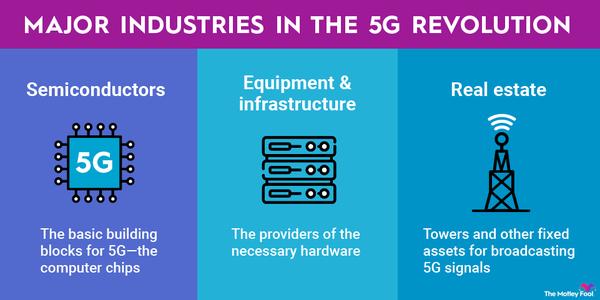The communications sector is broadly defined these days, encompassing everything from century-old legacy media companies to internet stocks.

Information technology companies use computers and software to help businesses and individuals stay connected. Telecommunications companies provide the infrastructure and services for distributing information. Television broadcast networks, broadband internet, and mobile wireless networks are also parts of the communications sector.
As we grow increasingly connected (and physically apart), the ability to send and receive information over distances becomes increasingly important. The communications sector will continue to produce important and valuable companies.
Best communications stocks in 2025
Best communications stocks in 2025
Here are five of the better stocks that are communicating with investors.
| Company name | Market cap |
|---|---|
| T-Mobile US | $296 billion |
| Comcast | $127 billion |
| Netflix | $411 billion |
| Alphabet | $1.9 trillion |
| Meta Platforms | $1.3 trillion |
1. T-Mobile
T-Mobile (TMUS -2.69%) is a leading wireless phone and internet service provider in the U.S. The company found itself in an advantageous position following its acquisition of Sprint in 2020, which provided it with valuable midband radio spectrum.
The carrier has deployed that spectrum quickly, building out the biggest 5G network in the U.S., and its coverage is well ahead of that of its biggest competitors. Going forward, T-Mobile should be able to attract customers based on the strength of its brand and service instead of relying on heavy promotions as it did in the previous decade.
T-Mobile also offers home internet service in markets where its mobile network capacity exceeds demand. As part of its merger with Sprint, it committed to covering 90% of rural households with home internet over 5G. That’s a sizable opportunity for the company since most rural areas have limited options for broadband internet. It’s also having success luring urban and suburban customers away from cable internet service. It's very close to its goal of reaching at least 7 million broadband subscribers by the end of 2025.
2. Comcast
Comcast (CMCSA -2.4%) is the largest cable television and internet service provider in the U.S. While its subscriber base is shrinking for both video and broadband internet, steady price increases and low costs make it very profitable. Its cable network is easy to maintain, and it can upgrade service with low incremental costs.
In 2018, the company acquired a majority stake in Sky, a leading pay TV operator in the U.K. and other European countries. It also operates a media company that produces sports, news, and entertainment television for its European audience.
Comcast’s NBCUniversal is one of the biggest media companies in the world. It includes global film and television productions, as well as a broad portfolio of U.S. cable and broadcast television networks. NBCUniversal also operates Peacock, a streaming service that gives it exposure to the direct-to-consumer media market.
Comcast plans to spin-off NBCUniversal's cable TV networks, but retain the film and television studios, broadcast networks, theme parks, and streaming service.
Comcast is building a wireless phone business to offset losses in the cable business. So far, it's seen good traction by bundling subscribers, and now counts more than 7 million subscribers.
3. Netflix
Netflix (NFLX -1.4%) has grown to become one of the most important media companies in the world over the past 15 years. Originally a DVD rental service, it pivoted to streaming video in the late 2000s, distributing licensed content to its subscribers. Now the company spends almost $20 billion annually on both licensed and original content for more than 300 million global subscribers.
Netflix is a beneficiary of the shift from pay TV to streaming entertainment. As the market leader in the space, it has the capital to invest in more content than its competitors and take more risks with its budget. As a result, it produces some of the best and most popular shows on television.
The company cracked down on password sharing and introduced a new ad-supported tier in 2023. The combination led to strong subscriber growth and expanded Netflix's reach. The ad-supported tier opens the door for substantial increases in revenue per subscriber without having to raise prices for consumers.
4. Alphabet
The core of Alphabet (GOOG -1.92%)(GOOGL -1.85%) is Google, which encompasses its namesake leading internet search engine, YouTube, Gmail, Android, and more. Google’s services are used by billions of people around the world, making it integral to how we communicate in modern life.
Google’s business is primarily supported by advertising. Its search engine is able to serve highly targeted ads based on search terms. User data collected from other Google products such as YouTube, Gmail, and Maps help improve its targeting. The sheer number of people using Google’s services makes it extremely attractive to advertisers looking to reach a broad audience, but its targeting capabilities make it suitable for any advertiser.
Google is also the home of Google Cloud, one of the leading cloud computing platforms. It has seen strong adoption of artificial intelligence (AI) services for developers, leading to accelerating growth. The cloud division only became profitable recently and still accounts for a small percentage of Alphabet's overall operating profits, but it's growing fast.
5. Meta Platforms
Meta Platforms (META -3.54%) changed the way we connect with friends and acquaintances with Facebook, and it has built Instagram into much more than just a photo-sharing app. It also counts billions of users across its messaging apps -- WhatsApp and Messenger. Meta’s products are the primary way some people communicate with others today.
The vast majority of Meta’s revenue comes from digital advertising on Facebook and Instagram. Its trove of user data develops accurate user profiles and its AI algorithms serve up the right ad at the right time to the right person for maximum effectiveness. As a result, its ads earn a premium price from marketers compared to other social media platforms.
Meta is investing heavily in artificial intelligence -- not only for its all-important recommendation algorithm, but also for opening the door to new products. Its Meta AI chatbot is one of the most widely-used in the world. It's working to develop a product for businesses to use AI agents for customer service and sales on its messaging apps as well.
Additionally, Meta is working to develop key technologies and platforms for the metaverse, the next iteration of the internet involving virtual and augmented reality. Besides changing its name to sharpen its focus, the company also has started breaking out results for its Reality Labs segment, which is currently reporting billions in annual operating losses.
CEO Mark Zuckerberg views the metaverse as an extended reality where people can work, play, and stay connected with friends and acquaintances. Owning the primary virtual reality platform for accessing the metaverse could prove extremely beneficial for the digital advertising company. In the meantime, however, it’s taking big operating losses as its advertising business faces a setback.
Analyzing these stocks
How to analyze communications stocks
The communications sector is broad and encompasses many different fields. It’s generally best to compare communications companies that mainly operate in the same industries or that are at similar stages of growth.
A communications company's user base size and engagement trends can provide insights into how a business or product is performing relative to the competition. One useful metric to consider is revenue per user, which investors might evaluate across a business segment or individual service. Many communications companies across industries will break out revenue on a per-account basis, providing a good measuring stick for comparing it to peers. And if you factor in how quickly the user base is growing, you can get an even better understanding of how two companies compare.
Companies that return cash to shareholders through dividends can deliver strong results even if earnings increase relatively slowly. Within the communication services sector, telecommunications companies are more likely to pay dividends than information technology companies.
The earnings growth for dividend payers, however, is typically slower. When you’re analyzing dividend-paying stocks, the key metrics include dividend yield, cash flow, and the number of consecutive years that a company has increased its payout.
Investors should also pay attention to a company’s expenses and whether those expenses are generating profit. For telecommunications companies, it’s important that capital expenditures -- money that companies invest to acquire and maintain crucial infrastructure such as internet cables, satellites, cell towers, and radio spectrum licenses -- are kept under control. For information technology companies, research and development (R&D) and content spending are indicators of how much they are prioritizing the creation of technology and products that can drive growth.
Related investing topics
Looking forward
The communications sector is poised to grow
The amount of data moving over long distances is growing every year. Whether it’s a simple text message on a mobile device, a film streamed over the internet, or important classified business communications, internet connectivity and 5G networks will only increase in importance, along with platforms that deliver information. Buying strong companies across the communications sector should produce good returns for investors as this trend continues.













